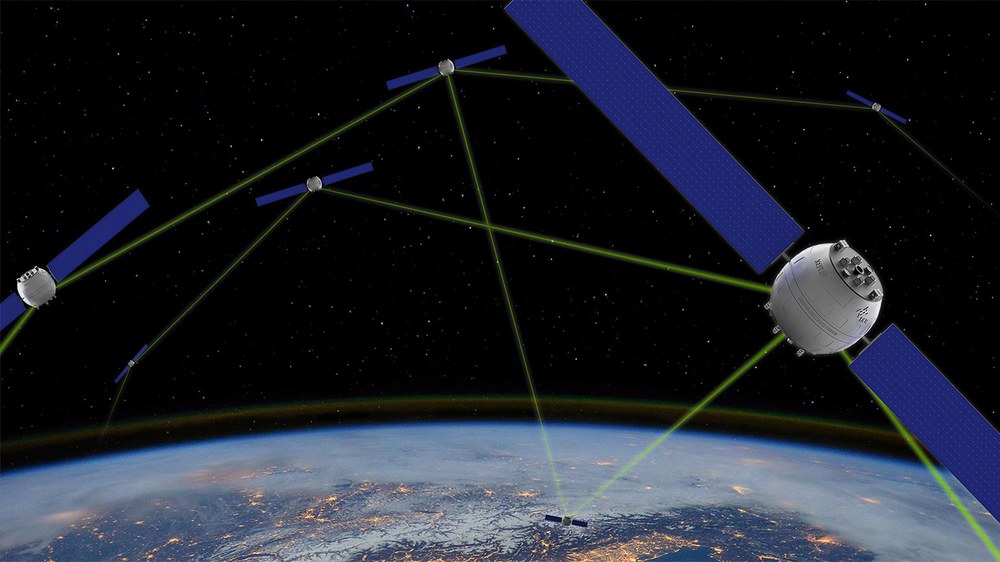Kepler - 3rd generation satellite navigation
With Kepler, the Institute of Communications and Navigation has presented a system proposal for a 3rd generation satellite navigation system - with unprecedented accuracy and reliability. It should make tomorrow's applications such as autonomous driving and flying possible.
Kepler is based on the networking of MEO satellites by means of optical intersatellite links, which enable precise distance measurement as well as time transfer between two satellites at a time. They also allow fast communication in the network so that the satellites can synchronize with each other. In addition, a small constellation of satellites in Low Earth Orbit (LEO) allows observations of the radiated signals without atmospheric interference. Together with precise optical ranging between selected satellites, this provides orbit determination capabilities with unprecedented accuracy.
The Kepler infrastructure thus consists of three main components:
- a constellation of MEO satellites networked by means of optical intersatellite links within the orbital planes
- a small constellation of LEO satellites for observing the radiated signals, for time transfer between the MEO orbital planes, and as carriers of some long-term stable clocks, and
- at least one ground station to maintain the system's coupling to the Earth's rotation.
MEO segment
Kepler uses the exact same MEO constellation as Galileo. Accordingly, 24 MEO navigation satellites will be placed in three orbital planes (semi-axis: 29600 km). This is to ensure a smooth transition from Galileo to Kepler. Each MEO satellite is equipped with a cavity-stabilized laser (wavelength 1550 nm) and with a direct optical link to the satellite ahead and behind on the same orbital plane. A third optical terminal on each MEO satellite provides connectivity to the LEO constellation satellites.
The optical terminals provide bidirectional inter-satellite links, thus supporting
- the precise global synchronization of all satellites (picosecond level)
- the precise range measurements between satellites (target accuracy: 40 µm)
- the fast transmission of measurements and data between all satellites (50 Mbps)
All these processes take place in the optical frequency domain. The synchronization - both in frequency and time - is transferred to the L-band by using a frequency comb, while maintaining the stability achieved in the optical domain. The L-band signals are then transmitted by the MEO satellites. The signals are backward compatible with Galileo and include some enhancements to increase the performance of the system.
LEO segment
The Kepler LEO segment consists of six LEO satellites located on two near-polar orbital planes (inclination: 89.7 degrees, semi-axis: 7600 km), with the lengths of the ascending nodes (RAANs) separated by 120 degrees. Each LEO satellite has three optical terminals to provide simultaneous bidirectional optical links to different MEO planes.
The LEO satellites are equipped with the same optical frequency reference (cavity-stabilized laser) as the MEO satellites. This allows for global synchronization. In addition, one or more long-term stable clocks, e.g., iodine-stabilized laser units, are included to realize a highly stable satellite-based time scale.
The LEO constellation provides three main functions: It…
- supports intra-system synchronization by establishing optical links to two MEO satellites at different orbital planes and relaying synchronization signals between the orbital planes
- enables precise determination of orbits and orbit positions by atmospheric-free observation of the transmitted navigation signals and the complete set of laser range measurements between the satellites
- carries an ensemble of long-term stable clocks on optical and/or microwave frequencies, maintaining the definition of the Kepler system time
Ground segment
The Kepler ground segment is autonomously capable of maintaining synchronization with the space segment, performing orbit determination, and providing robustness within the system. At least one ground monitoring station is necessary (and sufficient) to ensure synchronization of the Kepler constellation with the Earth's rotation. In addition, thanks to inter-satellite optical links, a single uplink station can communicate with any satellite in the system at any time.
Although one ground station is already sufficient to couple the system to the Earth's rotation, redundancies will be required in a practical implementation. Regardless, Kepler gets by with a minimal ground segment compared to existing GNSS.
Synchronization system
The cavity-stabilized lasers used in the Kepler system are characterized by a frequency stability of less than 10^-15 [s/s] (Allan deviation) for averaging times of up to 10 seconds. In contrast, all MEO satellites within the constellation can communicate with each other with a maximum latency of 795.6 ms. This allows all components of the system to be synchronized within a time interval well below the stability range of the cavity-stabilized lasers.
Each satellite is capable of realizing the Kepler system time locally by computing a composite time scale based on the measurements of the clock offsets shared in the system. The offsets of the local cavity-stabilized lasers with respect to the implicit ensemble mean are compensated for during the generation of the L-band signals on the MEO satellites.
Combined with the precise knowledge of the space segment topology, Kepler can thus largely eliminate the main factors influencing signal-in-space errors. This leads to an unprecedented precision and a very fast convergence of highly accurate position estimates, which has already been impressively demonstrated in simulations.
Projects
In the Kepler Vision project, the Institute of Communications and Navigation is refining the Kepler concept and continuously developing it according to requirements defined by the relevant institutions.
With Kepler, the Institute of Communications and Navigation has presented a system proposal for a 3rd generation global satellite navigation system (GNSS) – enabling significant navigation performance improvements compared to current GNSSs.
In the COMPASSO project, the Institute of Communications and Navigation, together with the Galileo Competence Center and the Institute for Quantum Technologies, is testing several optical elements (optical clocks and frequency combs) in low-earth orbits aiming at raising the TRL via a technology demonstration mission.

